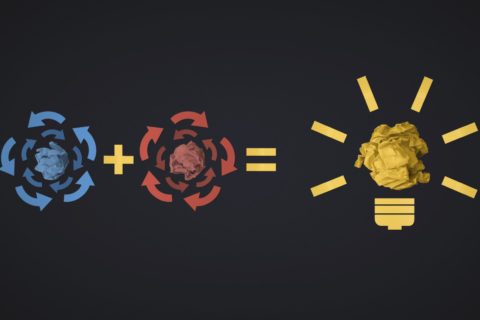Using behavioural research and insights to reduce the amount of unrequested goods sent during times of humanitarian crises.
This is a story about an unexpected truth, one that does not make intuitive sense for many good willed people. Here is the truth; most unrequested goods sent to humanitarian disaster zones end up in landfill, they actually do more harm than good. These goods are sent by kind, well intentioned people who are only trying to help, however there is an alarming gap between what they think their goods will achieve and what actually happens to the goods they send.
Recent examples of humanitarian disasters in the Pacific region include Tropical Cyclone Pam in 2015 and Winston in 2016. These Tropical Cyclones caused mass devastation to the local environment and communities. Media coverage of these disaster zones prompted good willed people to send unrequested goods to the humanitarian disaster zones; items such as old t-shirts, jumpers, shoes and toys. Despite being sent with good intention, these unrequested goods cause significant problems; they block supply chains, they create more work for the resources on the ground and also cost the local economy millions of dollars in sending them to landfill.
For example, 10 months after Tropical Cyclone Pam hit Vanuatu in 2015, the Australian Red Cross reported that there were still 18 shipping containers full of unrequested goods left on the wharf in Port Vila. These containers had reportedly accumulated approximately USD$1.5million dollars in storage, handling and container rental fees – costs borne by the Government of Vanuatu.
The concept of sending unrequested goods may be an unfamiliar thought to many, however our research revealed that 12.1% of Australians over 16 years-of-age say they would be very likely or extremely likely to send goods if a Pacific Island Country (i.e. Fiji, Vanuatu) had a humanitarian disaster. This is equivalent to more than three million Australians and represents major financial and logistical issues for future humanitarian crisis zones.
Understanding donors
Our clients, the Australian Council for International Development (ACFID) and the Australian Department of Foreign Affairs and Trade (DFAT) were looking to surface insight on how to better understand and influence this long-standing behavioural problem. Prior to our research, very little was known about the behaviour of unrequested goods donors. It was easily assumed that donors have good intentions and simply want to help those in need, however, there was no research to understand why they continue to send goods when they receive no feedback about the receipt of their goods or that they have had any positive impact. The brief for the research and strategy project identified a clear behavioural challenge; how can we reduce the amount of unrequested goods sent to humanitarian disaster zones?
There was no research to understand why they continue to send goods when they receive no feedback about the receipt of their goods.
Insights from Behavioural Science were used to generate hypotheses about donor behaviour. One of the key hypotheses was that donors were operating in a System 1 mode of thinking, an automatic mode that triggered goods donation behaviour, without stopping to consider the possibilities.
The behavioural research was conducted in various locations along the Eastern seaboard of Australia. The sample included a variety of different donor groups; holiday-makers, community groups, businesses, religious groups and diaspora from the Pacific Islands – all of whom had donated goods to humanitarian disaster zones in the past. The research was carried out in context and over time, looking to explore and understand the external and subconscious influences on donor behaviour.
This foundational piece of contextual research unlocked key insights into how to solve the behavioural challenge.The hypothesis about a System 1 mode of thinking was not only proven, but the research provided further insight. As it turned out, this System 1 mode of thinking was very prone to errors. Donors were simply imagining the positive impact their goods would have, despite the fact that there was no evidence for their visualisation, it was a key source of motivation. Furthermore, we observed additional triggers such as the social norm of the community, the public commitments made and the seeking out of confirmatory evidence for their behaviour. All of these behavioural triggers contributed to ‘locking-in’ their goods donation behaviour.
Possible solutions
It was very clear that this System 1 mode of thinking needed to be disrupted. We needed to find a way to encourage donors to stop and reconsider their decision to donate unrequested goods. The existing global strategy was to promote messaging that states, “cash is best”. The challenge with this strategy is that it does not disrupt donors’ existing beliefs about the positive impacts of donating goods. If donors inherently believe sending goods is a better way to help those in need, simply telling them that ‘cash is best’, will not be enough to change their behaviour.
Using principles from Behavioural Economics we developed four nudge ideas to be used in communications. Each of the nudge ideas was designed to test a different behavioural hypothesis;
- The existing strategy of Framing cash as best because it can transform into whatever is needed most
- Giving Salience to ports being clogged with shipping containers filled with unrequested goods – preventing life-saving aid from entering the disaster zone
- Reframing the delivery of goods to the disaster zone as slow compared to the instantaneous impact of cash, and finally
- Creating a disruptive Anchor point around the fact that most unrequested goods sent to humanitarian disaster zones end up in landfill.
In February 2018, the four BE inspired nudge messages were taken into quantitative testing with over 1000 Australians who had either donated goods previously or were highly likely to do so in the future. Of the four messages, the one that stated the fact that “most unrequested goods end up in landfill”, was significantly more disruptive, and subsequently, more behaviourally effective than the others. The ‘Landfill’ communication reduced the likelihood that a participant would send goods by 50.1%. The ‘cash only’ message, which is currently used globally, achieved only a 23.4% reduction in likelihood to donate goods. The landfill message was more than twice as effective as the communications that are currently being used globally.
Understanding why
Given the significant difference in effectiveness of the nudge ideas we conducted further analysis to understand why the landfill message was so effective. The word ‘landfill’ and image featured in the concept provided a quick System 1 shortcut, or heuristic for ‘waste’. There is cognitive ease associated with the message, a mental picture of landfill is very easily brought to mind and can only be a negative association. It is a definitive ‘full stop’ to the journey of a donated good, and therefore, there is no ambiguity or possible rationale that could still provide justification for sending goods.
In contrast, the messages about delays, clogging and cash are more ambiguous and invite System 2 thinking and evaluation. With all three of these messages, likely donors found ways to justify why a delay might be a good thing, how clogging could be avoided or why cash is incorrectly anchored to the misappropriated spending of NGOs.
In concluding this project, there was an important distinction that needed to be made clear; reducing the amount of unrequested goods sent does not automatically result in increased cash donations. The two behaviours; sending goods and donating cash, are not opposite sides of a coin – reducing one does not automatically result in increasing the other. In fact, the quantitative research showed that despite the ‘landfill’ message reducing intention to send goods to single digits, there was still 40% of people who stated that they would not give cash. There is a need for further research into the behaviour of donating cash to fully understand how to maximise cash donations.
There is a need for further research into the behaviour of donating cash to fully understand how to maximise cash donations.
This foundational piece of behavioural research into understanding the motivations and rewards of unrequested goods donors was the first of its’ kind. It has surfaced genuinely new behavioural insight as well as guided the development of highly disruptive and behaviourally effective nudge ideas that have been shown to reduce the likelihood of sending unrequested goods at twice the rate of current communications. This contextual research, together with insights from Behavioural Economics, have produced a behavioural strategy and nudge idea that is currently being distributed amongst ACFID’s NGO members. These insights will also be developed into communication tools that can be shared the world over, helping to reduce the negative impact caused by unrequested goods that are sent to humanitarian disaster zones.
This article by Melissa Gil is based on the paper that won the ESOMAR Best Paper Award at ESOMAR’s APAC 2019 conference.


